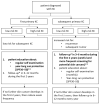Risk Factors and Clinicopathological Features for Developing a Subsequent Primary Cutaneous Squamous and Basal Cell Carcinomas
- PMID: 35804841
- PMCID: PMC9264931
- DOI: 10.3390/cancers14133069
Risk Factors and Clinicopathological Features for Developing a Subsequent Primary Cutaneous Squamous and Basal Cell Carcinomas
Abstract
Background: Patients with diagnosed keratinocyte carcinomas (KCs) have an increased risk of subsequent skin cancers development. Current studies indicate that patients with subsequent tumors should be followed up regularly. However, none of the studies indicate the connection between the specific subtypes and an increased risk for further KCs development. The study assesses the differences in the risk of developing a subsequent skin cancer after a previous diagnosis of KC, especially considering individual types of skin malignances, and identifies potential factors associated with an increased risk of new cutaneous tumor describing non-invasive diagnosis and monitoring.
Methods: Pathology and medical records were examined to identify the characteristics of patients with multiple KCs diagnosed between 1999 and 2019.
Results: The study group comprised 13,913 KCs occurring in 10,083 patients. Multiple KCs were observed in 2300 patients (22.8%). The analysis showed aggressive subtypes, multiple tumors, and male sex as significant prognostic factors.
Conclusions: The most crucial risk factors for developing subsequent KC are being of a male gender, an aggressive tumor subtype, and previous history of multiple skin cancers. Basal cell carcinoma subtypes, such as infiltrative basosquamous, with aggressive growth patterns predispose not only to increased risk for the recurrence but are also expected to be at higher risk of subsequent KCs.
Keywords: basal cell carcinoma; keratinocyte carcinomas; non-invasive diagnosis and monitoring; non-melanoma skin cancer; squamous cell carcinoma.
Conflict of interest statement
The authors declare no conflict of interest.
Figures
References
-
- Smeets N.W., Kuijpers D.I., Nelemans P., Ostertag J.U., Verhaegh M.E., Krekels G.A., Neumann H.A. Mohs’ micrographic surgery for treatment of basal cell carcinoma of the face--results of a retrospective study and review of the literature. Br. J. Dermatol. 2004;151:141–147. doi: 10.1111/j.1365-2133.2004.06047.x. - DOI - PubMed
Grants and funding
LinkOut - more resources
Full Text Sources
Other Literature Sources




